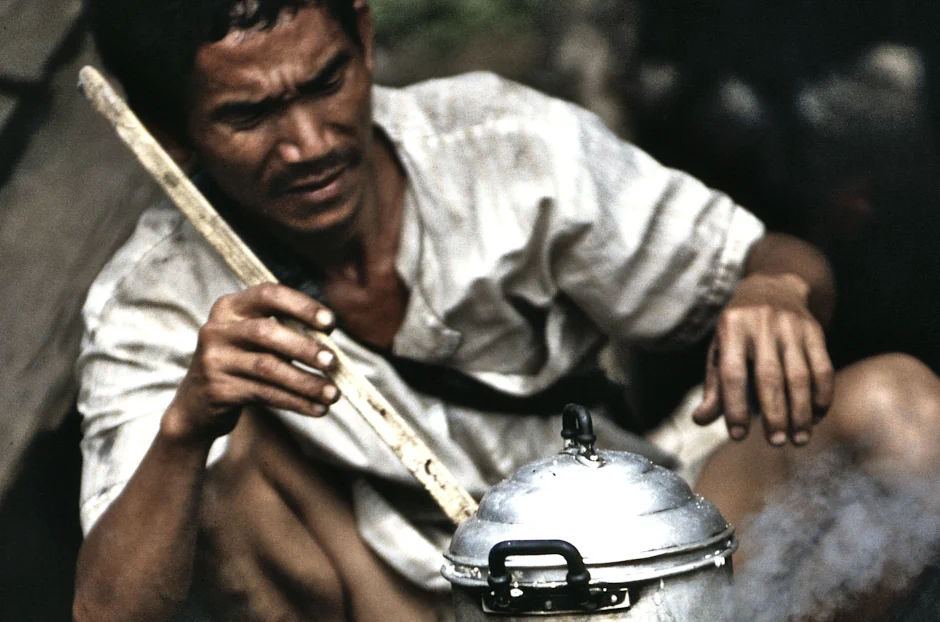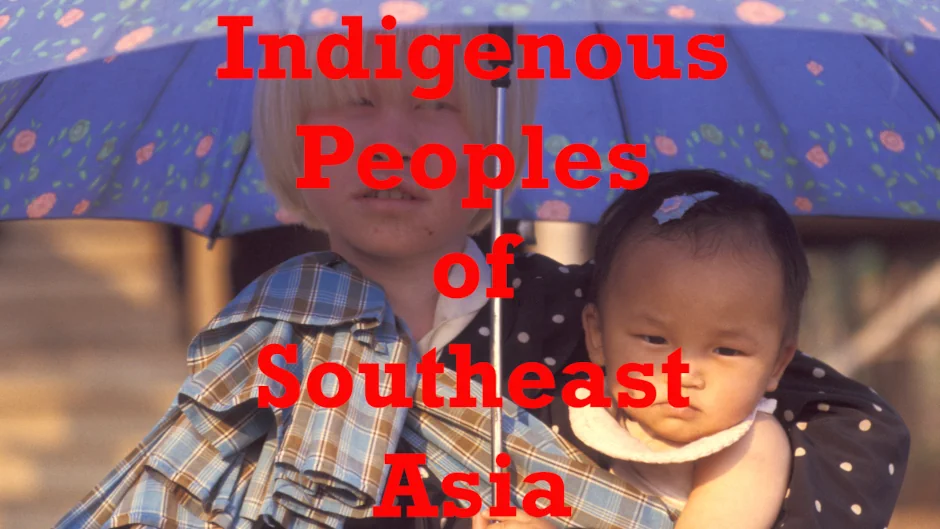The Indigenous Lahu People
Ethnonyms: Lohei, Luohei, Lahuna, Launa, Laku, Kaixien, Namen, Mussuh, Muhso, Mussur, Musso, Mussar, Mooso Countries inhabited: Burma (Myanmar), China, Lao PDR, Thailand, USA, Vietnam Language family: Tibeto-Burman Language branch: Lolo

This sign, posted at the entrance to an indigenous Lahu village in northern Thailand, explains to visitors the changes being faced by the Lahu people today. It could have been written about almost any indigenous people anywhere in the world.
In reality, the past thousand years have been changing times for the Lahu: They are one of the most culturally diverse ethnic minority groups in the world. In fact, one Lahu person can often recognize another as belonging to their ethnolinguistic group only when they speak to each other in the same language.
Their religious practices range from Animism to Christianity, their dress from traditional, hand-woven cloaks to jeans and T-shirts, and their lifestyle from semi-nomadic to sedentary.
Some speak no language except their indigenous Lahu, while, in southwestern China, many also speak the local Yannanese fluently; yet others no longer speak Lahu at all. The Lahu who have migrated to the United States will also eventually stop speaking their language.
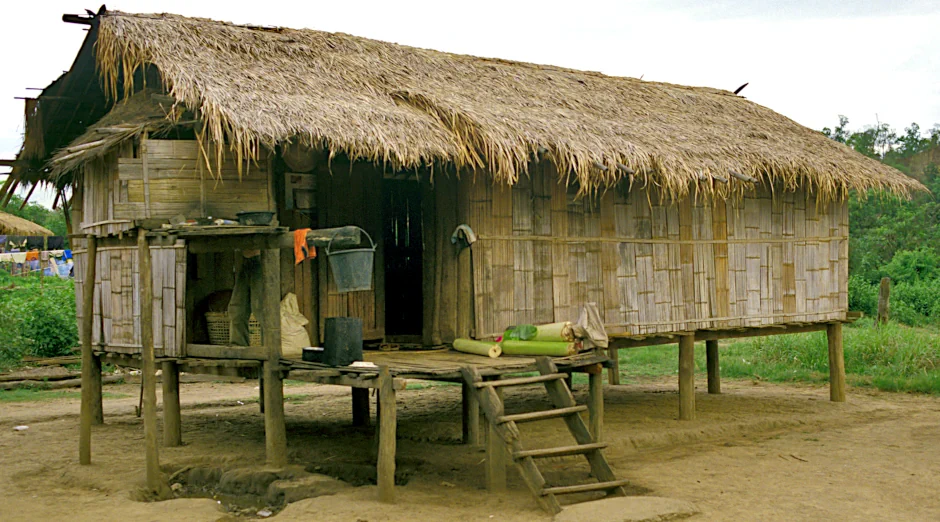
The "traditional forest home" mentioned in the sign is still found in most Lahu villages. Usually built on stilts using split bamboo for walls and grass for roof thatch, these small houses have no running water or electricity. Underneath the house are kept the family livestock — including chickens and pigs.
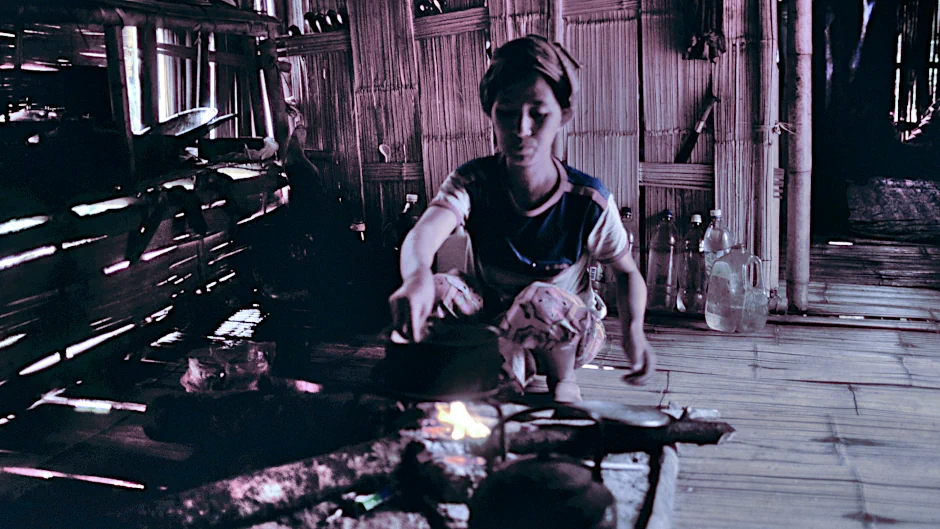
Inside, one finds a supply of bare-bones essentials: partitioned sleeping quarters with a mat for a bed and a kitchen of sorts with a wood-burning hearth on the floor. The kitchen doubles as a social gathering place for the inhabitants.
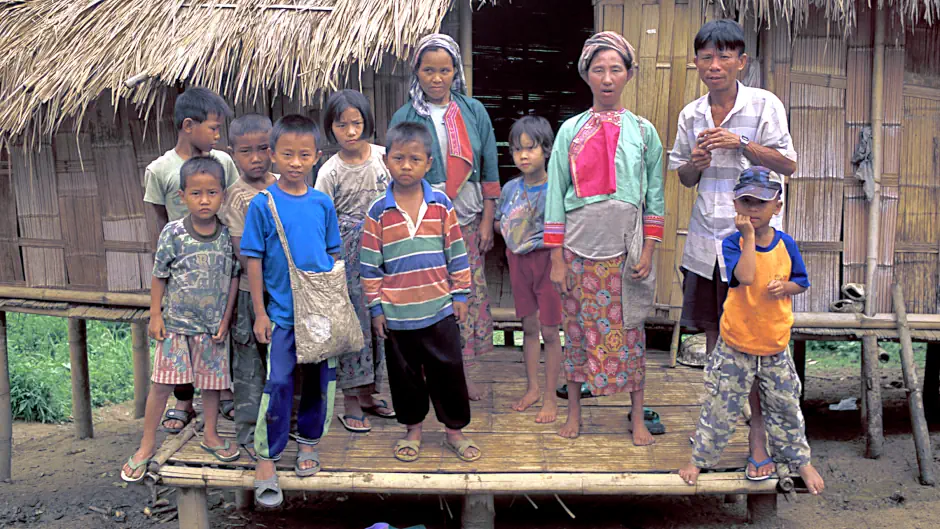
The inhabitants themselves are mostly a nuclear family of parents and unmarried children. Often, they will also include one or more sons-in-law and grandchildren. It is a Lahu tradition that a man live with his wife's parents, at least for the first few years after marriage, and provide labor. The labor may be provided for a longer time if it is given in lieu of a dowry payment for his bride.
Since it is common to have ten or more children, the house can get very full. Usually, though, as soon as the next daughter gets married, the previously married couple will build a new house for themselves in the wife's village.
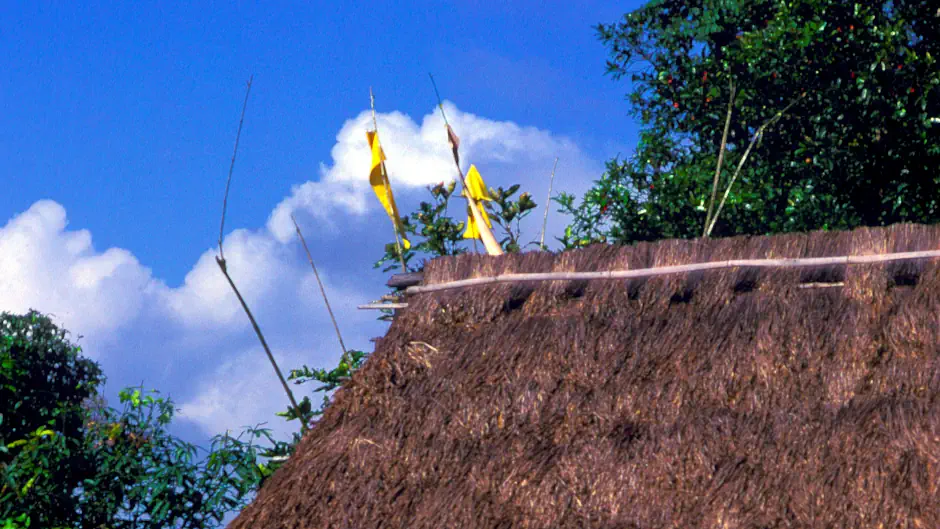
You are unlikely to find evil spirits in one of these new houses for a couple of reasons. First, when the construction is finished, evil spirits are driven out of the building materials in a ritual ceremony, which is the Lahu equivalent of a house warming party. This, they believe, is essential before the new family begins living there — otherwise ill fortune (lack of blessing) will likely befall that family. Second, every house in the village is protected from evil spirits by the yellow and white streamers one sees towering above the roof of the village's head house.
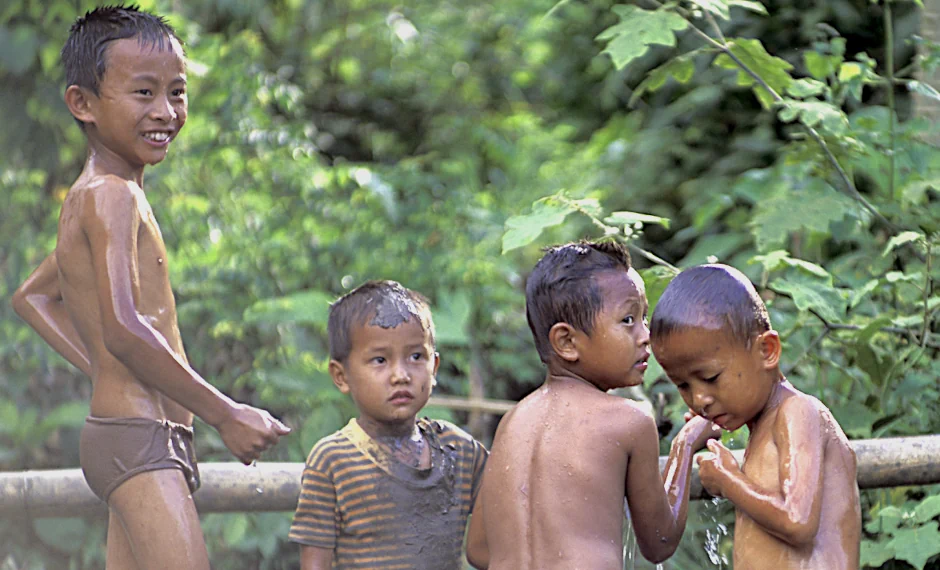
Originating in China in the area around the Tibetan plateau, the Lahu have migrated in the past two hundred years to bordering Southeast Asian countries and also, in 1975 as refugees, to the United States. The current world Lahu population is around one million. Most of these still live in Yunnan Province, southwestern China. A few thousand live in each of Vietnam, the Lao People's Democratic Republic, and the United States. The rest have settled in Burma (Myanmar) and Thailand.
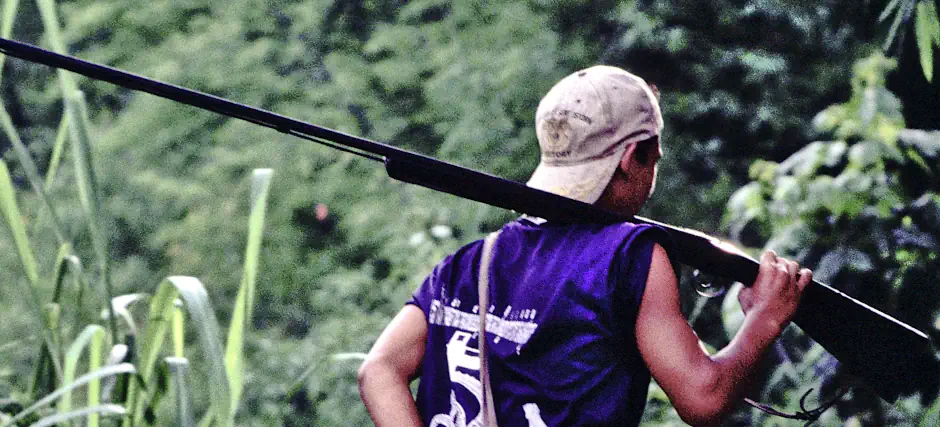
The Chinese call the Lahu "tiger hunters." It is uncertain how this designation originated, but the "La" stem of their name means tiger in their own language and, to this day, much of the meat they eat comes from hunting wild animals — including tigers. The Thai name for the Lahu, mussur, means hunter.
The technology may have changed from crossbows to guns, but they still hunt with the same enthusiasm. Most of us have never experienced hunting in the part of the world where the Lahu live. Dense, semi-tropical, monsoon rain forest, this land is home not only to wild tiger but also boar, deer, poisonous snakes and dozens of other species which make a fine meal.
One Western man who has experienced hunting alongside the Lahu is Gordon Young. His fascinating book, Tracks of An Intruder, documents the years he spent living and hunting with them. (See the references at the bottom of this page.) The tiger also features in a somewhat bizarre part of Lahu mythology, which recounts the first solar eclipse when a tiger ate the sun.
Whatever others may call them, the Lahu call themselves "children of blessing." References to blessing are found everywhere in their prayers, rituals, ceremonies, mythology and folklore. These blessings take the forms of successful hunting, bountiful crops, large families and long, peaceful, healthy lives.
The Lahu look to many sources for these blessings, the main two of which are their ancestors and their God of creation, G'ui sha, who controls all other spirits. Offerings and animal sacrifices are made regularly to these and other spiritual sources of blessing in both cyclical and ad-hoc ceremonies. For example, the village headman may call for an ad-hoc ceremony when a person becomes sick.
Not surprisingly for a people who are mainly subsistence farmers, daily life and ritual revolves around the agricultural seasons. None of these is more important than the New Year, which takes place right after the rice harvest. This is a time of celebration and thanksgiving offerings to the God of Rice (or perhaps animal sacrifice to appease that God if the harvest has been a poor one).
Rice is important to the Lahu not only as a staple, dietary crop, but in their spiritual and mythological worlds also. Even among those Lahu who now consider themselves Christian or Buddhist, one still finds an ancestral altar in the village headman's house. It is here that, among other things, rice cakes will be placed as an offering to their ancestors in hope for the blessing of the living.
The Lahu have their own mythological account of the creation of the Universe. This story has been passed down through generations by orators, who can provide an entire evening's entertainment if it is told in full. (It was published in English only in 1995. The full reference for the book is given at the bottom of this page.) One fascinating part of the story explains why some peoples have a writing system for their language while others, such as the Lahu, don't. When G'ui sha handed down His Word to the different peoples, He wrote them down for the Lahu on rice cakes. Since rice cakes are such a delicacy, they were eaten immediately. This is why the Lahu no longer have a written form of their language.
These days, most Lahu have adopted the festive calendar of the country they live in. In Thailand, for example, I saw many Lahu throwing just as much water during Songkran (the Buddhist New Year festival) as their Thai neighbors.
However, New Year is also a time when the Lahu celebrate their own heritage. In village after village, men and women, young and old, wear traditional Lahu clothes, made anew for the occasion, and they sing, dance and drink all day and night. Children walk from house to house with offerings of uncooked rice for the head of the household, which are later cooked together, symbolizing village unity. Traditional music is played on wind instruments made from gourds and bamboo stalk.
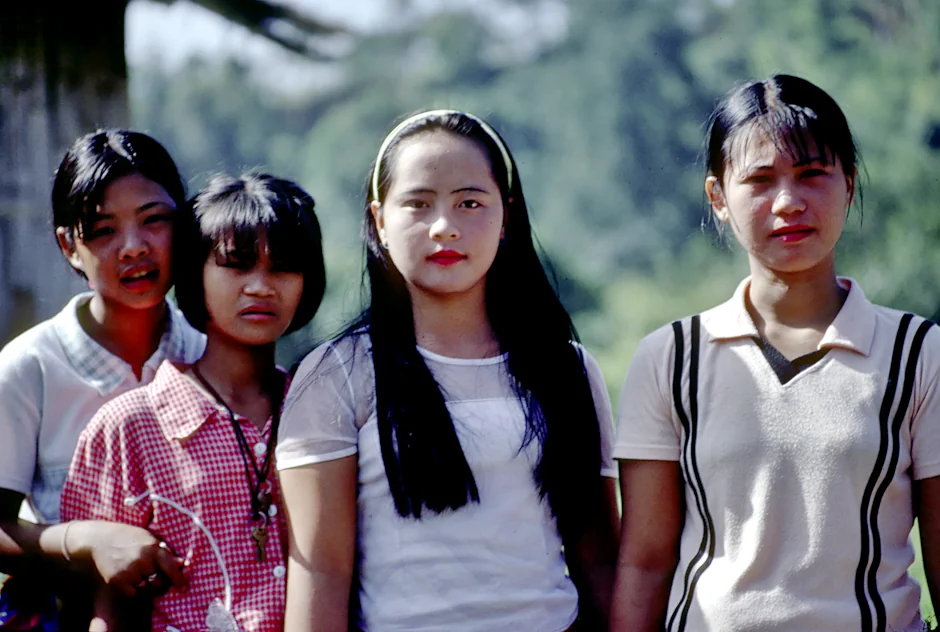
This is also the time when young Lahu men begin seeking a wife. The average age for marriage has increased in recent times, but it is still quite common for a boy in his mid or late teens to marry a girl in her early or mid teens. While divorce is not uncommon these days, it is far from the norm.
The Lahu have one of the most egalitarian social systems in their part of the world: Women have equal social standing with men, who are expected to share in both child rearing and daily household work. While most societies are classified as either matrilineal or patrilineal (children are given the family name of either their mother or father), the Lahu have neither system. Traditionally, Lahu children bear no family name. Instead, their first and only name has two parts: The first indicates whether the child is male (Ca) or female (Na), the second indicates either sibling birth order or the animal of the 12-day cycle on which they were born. Thus, Lahu names can sound very repetitive.
If a very young child falls sick or cries more than usual, the Lahu believe this to be because the wrong name was given (the child was meant to be born on a different day) — they will then hold an ad-hoc ceremony just to re-name that child.
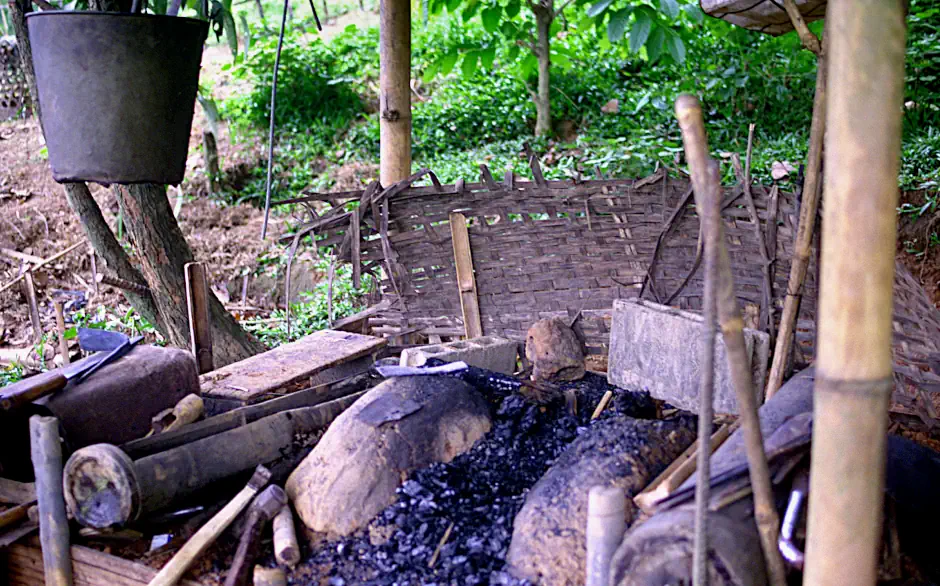
Besides growing and cooking rice (I can't think of a meal I ever had in a Lahu village that didn't include rice), hunting and animal husbandry, other skills highly developed among the Lahu include weaving fabric and baskets, embroidery, blacksmithing and jewelry making.
And, of course, receiving the gift of blessing.
Photography copyright © 1999 - 2025, Ray Waddington. All rights reserved. Text copyright © 1999 - 2025, The Peoples of the World Foundation. All rights reserved.

Waddington, R. (2002, revised edition 2023), The Indigenous Lahu People. The Peoples of the World Foundation. Retrieved December 17, 2025, from The Peoples of the World Foundation. <https://www.peoplesoftheworld.org/text?people=Lahu>
Web Links Preserving the Tiger Hunters Suan Lahu Books Young, G., (1970) Tracks of an Intruder. New York: Winchester Press. A. Walker, ed. (1995) Mvuh Hpa Mi Hpa Creating Heaven, Creating Earth: An Epic Myth of the Lahu People in Yunnan. Chiang Mai: Silkworm Books.


